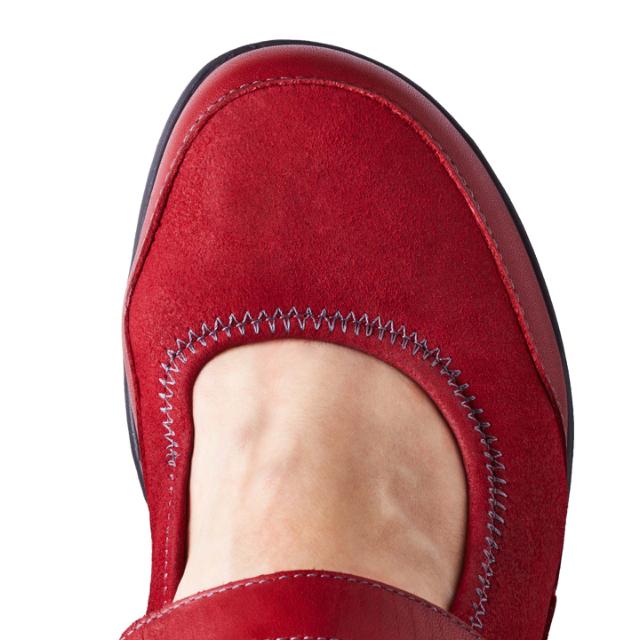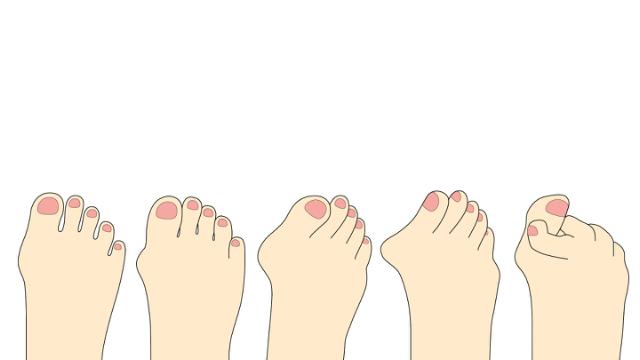Feet and bunions
A crooked big toe (hallux valgus) is also called a bunion, which occurs when the bones in the big toe slowly move outwards. This causes the big toe to start pointing towards the other toes on the foot, or in some cases, to go over the other toes.
The bunion can cause great pain, and osteoarthritis can occur in the joint over time. Many also have other changes and misalignments in their feet, such as flat feet, where the arches of the foot are flattened out - or hollow feet - where you are born with a very high arch. Often you have the combination of hammer toes, bunions and flat feet.
You will experience soreness and pain in your other toes and in your arch when you have a crooked big toe. You unconsciously change the way you walk when you have pain, and it can give rise to pain elsewhere due to changed load.
Our big toe is our "joystick" when walking, and it should preferably be as straight as possible. We are naturally born with a nice foot-shaped form. The big toe has an important job in making our gait a more "fluid movement", so that the knees, hips and back can help to promote a normal gait.


Causes of crooked big toes and bunions
A crooked big toe with a bunion can be hereditary, but most often it is due to inappropriate footwear. As said, the combination of flat feet, hammer toes and bunions is very common. However, the cause can also be other diseases that affect our joints, for example, both rheumatoid arthritis and osteoarthritis can affect our feet. Also, walking on a hard surface for many hours can have a negative impact.
> Read more about feet and arthritis here
The best and easiest thing is of course to completely avoid getting bunions and maintaining the foot-shaped form of your foot. However, if the injury has occurred, there are some things you can do to slow down the development and prevent your big toe from becoming stiff and no longer able to move.
Choice of footwear
The first step on the way to help your bunions is to wear footwear with plenty of room for your foot - in length, width and height above the toes and bunion. Footwear with a high heel should be avoided as it helps to move the pressure from the heel to the forefoot. The bones of the forefoot are not made to withstand this pressure.
There are many different types of footwear to choose from, and it can be hard to know what good and sensible footwear is. There is a difference between whether your footwear is to be worn for a party, everyday or exercise. Your daily footwear should be some of the best you have and be good for your feet. Footwear should protect your feet and help make your gait as natural as possible.
Your shoes must fit your feet – your feet must not fit your shoes.
> See our shoe guide with good tips for choosing footwear here
Insoles can relieve your bunion
Maybe you need an insole. It is a good idea to check if you have misalignments in your foot, and in many cases, an insole will alleviate your discomfort. An insole aims to relieve, support, correct and to some extent train your feet. This means that pressure is distributed so that pain and discomfort are less, and thereby your gait is improved.
There are many different types of insoles that can relieve your bunion. If you have misalignments such as flat feet or hollow feet, there is a greater risk of getting problems with your feet, and in such a case, you can really benefit from an insole.
Ready-made insoles can be an excellent remedy for many people.
Read more about New Feet;s insoles here: Korrektor®
and New Feet's shock-absorbing soles here: Protektor®.
Sometimes a ready-made insole is not enough and there will be a need for custom insole made especially for you so that you are supported exactly where your feet need it. It is important not to go too long with the pain, so consult a doctor, practitioner, orthotist or a physiotherapist to get an assessment of the cause and get suggestions for treatment.
It is also possible to have minor relief made in different materials by practitioner or orthotists that you can use in combination with insoles and appropriate footwear.
It is important to look after your feet
If we are to be able to keep walking the 10,000 recommended steps daily, it is important that we train our feet. The benefits of training your feet:
- Greater flexibility - If your feet are pliable and flexible, then your whole body can move better - this also gives better balance.
- Prevents injuries - Many problems with the knees, hips and back occur when the foot's suspension and turning function is impaired.
- Better blood circulation - Blood circulation is promoted, and you will find it easier to keep your feet warm and if you have swollen feet, it is really good to do articular pump exercises.
- Quick recovery. The more effortlessly and freely we move, the better we recover.
- Wellness - If you want to stay healthy and fit all your life, it is important to have good and mobile feet for as long as possible.
Your feet are your body's foundation – they must support you all your life.
Have you been diagnosed with a disease?
If you have been diagnosed with a disease that requires special footwear or insoles, it is important that you listen to your practitioner's advice. Experimenting on your own can have serious consequences. We and our resellers are happy to advise, but it is your practitioner who has access to your medical history and so the practitioner's advice is very important.